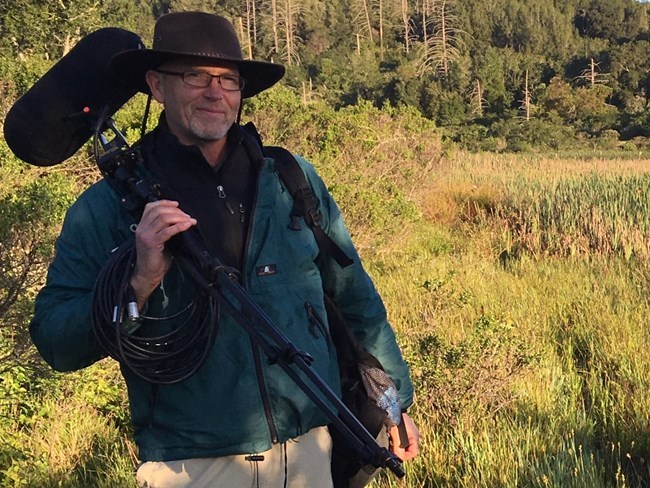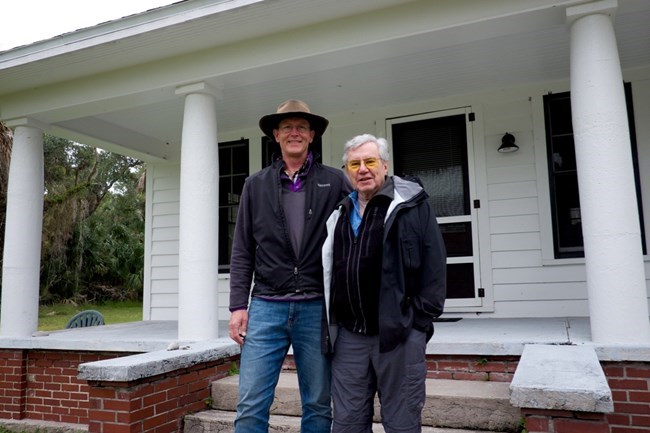Last updated: May 3, 2025
Article
Artist-In-Resident 2019

NPS/Photo
Featured Artist-In-Residence 2019
Jack Hines
Soundscape Specialist
Glen Ellen, CA 95442
Musician,environmental advocate, GIS technician, fieldrecordist,soundscape ecologist, and educator, Jack Hines hasbeen an associate member of the Wild Sanctuary team for nearly20 years.
His deep understanding of sounds of the natural wild, theirrelationship to music, and to those of enhancing human healthand wellness, make him a multi-talented leader in this field.Both studied and intuitive, Jack’s comprehensive field andteaching skills along with his enthusiasm to share the wonders ofthe outdoors - and relate them to life in the modern world - aretimely and vital.
A versatile and accomplished songwriter and musician, Jack is a vocalist, plays bothelectric and upright bass, viola da gamba, guitar, and piano, receiving a BA in Musicfrom San Francisco State University in 1988. Performances include Hong Kong,Singapore, and Kuala Lumpur tours. Jack’s San Francisco Bay Area collaborations haveranged from Jazz to Brazilian to Afro-Cuban and Salsa styles, along with a variety ofother performers, musical partners, and bands.
In 2004, Jack became a full-time music teacher working with at-risk adolescent boys at alarge residential center in Sonoma, CA., producing concerts twice a year for 15 years,where he also led guided wilderness backpacking trips and day hikes. In this capacity,his skills with guided meditation, life coaching, wilderness awareness and ecologyfostered new environmental connections and launched many related programs for hisstudents.
Under his own label, Jack has produced 6 albums, including: Howard Lake, Ledson Marsh,Magpie’s Song, Moab, Death Valley Oasis, and Pinyon Forest Dawn.For further information visit: www.EarToTheWild.com
Wild Sanctuary albums with Bernie Krause include: Sequoia High Country.For further information visit: www.WildSanctuary.com
Jack is a Wild Sanctuary field associate, sharing natural soundscape awareness for science, art, education, and public outreach. He’s recently completed two extensive European field-recording explorations within Romania (REX) and the Scottish Highlands (S:HEX); a collaborative sound-led project with Wild Sanctuary, Missing Wolf, and Ear to the Wild.

NPS/Photo Eve Payor
Inaugural Artist-In-Residence (AIR) Creative Contribution 2019
Welcome to the first ever sound tour of Canaveral National Seashore! Open your ears, close your eyes, and let it take you on a journey through the various habitats and moods of nature found at the seashore. While moving geographically from the ocean’s shore across the narrow barrier island to the lagoon, you will also be guided through the phases of the day, from the awakening of dawn, to the contemplation of dusk, and the lullaby of owls in the night. Notice as you’re listening that each place has it’s own distinct soundscape, or collective expression of voices and sounds.
We start at dawn with the crashing waves at the Sandy Shore where a lone Ruddy Turnstone (00:25) is barely heard, and then a Ring-billed Gull’s sharp call (00:49) cuts through the roar of the surf. As we move slowly inland, across the Dunes and into the Saw Palmetto we hear an Eastern Towhee (1:21), Grey Catbird (1:27), and Carolina Wren. We then arrive at the Salt Marsh (3:05) where the lapping waves of the lagoon can be heard, as well as a park visitor listening to music while arriving on a motorcycle. About a minute later a Common Loon (4:05) can be heard in the distance, followed by the Carolina Wren again (4:18), and a Marsh Wren (4:35). From the Salt Marsh we follow the sound of an airplane (4:41) as we move north into the Coastal Hammock (5:10), a habitat that is largely made up of Live Oak and Sabal Palm. We are introduced to it by a brief call of the Pileated Woodpecker (5:14) before hearing the distinctive cry of a Red-shouldered Hawk (5:23), followed by the Carolina Wren (5:33), and then a Sandhill Crane (5:44) in the distance. Also notice the water droplets falling from the leaves onto palm fronds as well as more Grey Catbirds in the background. From the hammock we follow the sound of a power boat (6:23) out onto the waters of Mosquito Lagoon. Listen carefully as the perspective shifts from above water to below the surface where you hear the underwater cavitation signal of a boat’s propeller (6:35), the above surface sound of a Bottlenose Dolphin breathing (6:47), and then it’s use of echolocation while hunting for fish (7:03).
You will notice a crackling sound during this underwater portion of our sound tour. These are Snapping Shrimp (7:59) - otherwise known as “Pistol” Shrimp - and can be heard throughout the Indian River Lagoon estuary system. No tour of Canaveral National Seashore would be complete without the West Indian Manatee who’s gentle chirping can be heard starting at 8:07. As the Manatee fades we rise back to the surface of the water where we hear a flock of Ring-billed Gulls (9:06) circling. The wind then picks up and carries us to the Visitor Center where we hear a cable knocking against the flagpole (9:51), the American flag flapping in the wind, and a juvenile Bald Eagle calling (9:57) as a thunder storm (10:10) moves in. A quiet period of rain follows as more thunder rolls through, and then we hear the dripping of rainwater in puddles (11:04) at the front porch of Doris Leeper’s house. Cicadas (11:23) bring us out of the storm and into late afternoon and dusk as we begin to hear the sounds of the lagoon’s Red Mangrove shore. In the distance we hear the rumble of traffic from highway 1 and the Intracoastal Waterway, two to three miles across the lagoon to the west. Then we hear a Great Blue Heron (11:48) fly over, followed by the unique voices of two Sandhill Cranes (12:06), an Osprey and Belted Kingfisher (12:21), a Mullet jumping and splashing (12:36), a Black-crowned Night-Heron (13:01) passing over, and finally Clapper Rails (13:15) bringing on the night. The early evening is made peaceful by the gentle lapping of waves at the lagoon shore accompanied by what sounds like insects, but are actually several Little Grass Frogs (13:30) mixed in with crickets. As our sound tour transitions into night we’re lulled to sleep by a duet of two Great-horned Owls (14:32), and the chuffing sound of White-tailed Deer (14:41). Lastly, the rumble in the distance grows as a train on the East Coast Florida Railway passes three miles to the west, it’s distant whistle mixing with the owls’ patient hoots.
Jack Hines, 20 December 2019
End note: With this activity we wear two hats: One, in the role of soundscape ecologists, where we study as scientists the recorded signals emanating from both marine and terrestrial habitats. With the field data we collect, we analyze and publish the results of our findings. Our publications, while important, are read by a relatively small number of colleagues who take into account the consequences of our efforts and consider them for further research. For us, this is not sufficient enough exposure to larger audiences who really need access to our findings so that they can make informed decisions about the future well-being of their respective biomes. To address that goal successfully, we must wear our artist hat.
Through the lens of the arts, we focus more on emotional impact to put our ideas and findings across. As soundscape artists, we show how the power of sound illustrates the incredible wonders occurring in the natural world. David Bowie once said that ‘the future belongs to those of us who can hear it coming,’ All of the proofs are there – just in a different voice not usually considered, before.
With science, we stick to abstract numbers and sometimes esoteric rationale to explain the outcomes of our work.
As artists, however, we can create events we most want to hear manifest in the natural world. What’s unusual about this material is that it reaches audiences of all ages, cultures, language groups, and interest without the usual biases. That’s because natural sound is embedded deeply in our DNA, a vestige of ancient times when we lived more closely connected to and engaged with the life-affirming forests and deserts from which we sprang.
Bernie Krause, PhD
20 December 2019
Sound time stamps:
00:00 Sandy Shore & Dune GPS: 28.856641, -80.775116
00:25 Ruddy Turnstone
00:49 Ring-billed Gull
01:15 Saw Palmetto Flatland GPS: 28.856126, -80.775845
01:21 Eastern Towhee
01:27 Grey Catbird
01:27 Carolina Wren
03:05 Salt Marsh
04:05 Common Loon
04:18 Carolina Wren
04:35 Marsh Wren
04:41 Airplane
05:10 Coastal Hammock GPS: 28.903106, -80.816189
05:14 Pileated Woodpecker Dryocopus pileatus
05:23 Red-shouldered Hawk Buteo lineatus
05:33 Carolina Wren
05:44 Sandhill Crane
06:23 Power boat
06:35 Boat sound underwater
06:35 Mosquito Lagoon
06:47 Common Bottlenose Dolphin Tursiops truncatus
07:59 Snapping Shrimp Alpheus heterochaelis
08:07 West Indian Manatee Trichechus manatus
09:06 Ring-billed Gull
09:51 Visitor Center
09:51 Flag pole and flag flapping
09:57 Bald Eagle, juvenile Haliaeetus leucocephalus
10:10 Thunder storm
11:04 Rain water in puddles
11:04 Doris Leeper’s porch GPS: 28.903151, -80.817374
11:23 Little Brown Cicada Cicadetta calliope
11:44 Mangrove shore GPS: 28.906181, -80.820020
11:48 Great Blue Heron Ardea herodias
12:06 Sandhill Crane
12:21 Osprey
12:21 Belted Kingfisher Megaceryle alcyon
12:36 Mullet
13:01 Black-crowned Night-Heron Nycticorax nycticorax
13:15 Clapper Rail
13:22 Lagoon shore at night GPS: 28.857945, -80.777296
13:30 Little Grass Frog
14:30 Coastal Hammock
14:32 Great-horned Owl
14:41 White-tailed Deer Odocoileus virginianus
15:53 Train in the distance
